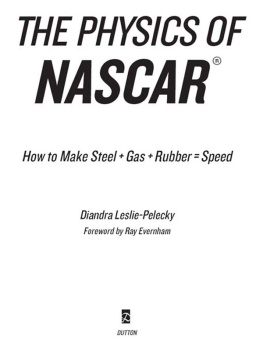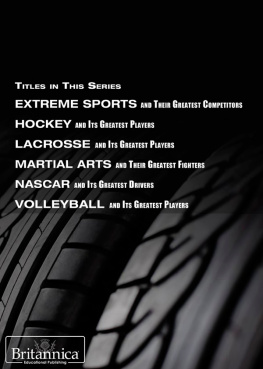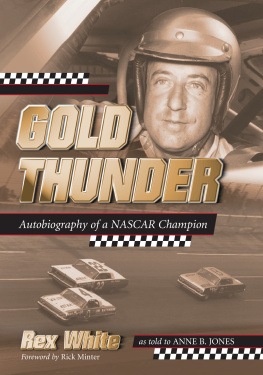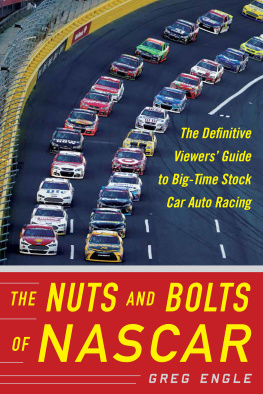THE PHYSICS OF NASCAR
How to Make Steel + Gas + Rubber = Speed
Diandra Leslie-Pelecky
Foreword by Ray Evernham

DUTTON
DUTTON
Published by Penguin Group (USA) Inc.
375 Hudson Street, New York, New York 10014, U.S.A.
Penguin Group (Canada), 90 Eglinton Avenue East, Suite 700, Toronto, Ontario M4P 2Y3, Canada (a division of Pearson Penguin Canada Inc.); Penguin Books Ltd, 80 Strand, London WC2R 0RL, En gland; Penguin Ireland, 25 St Stephens Green, Dublin 2, Ireland (a division of Penguin Books Ltd); Penguin Group (Australia), 250 Camberwell Road, Camberwell, Victoria 3124, Australia (a division of Pearson Australia Group Pty Ltd); Penguin Books India Pvt Ltd, 11 Community Centre, Panchsheel Park, New Delhi110 017, India; Penguin Group (NZ), 67 Apollo Drive, Rosedale, North Shore 0632, New Zealand (a division of Pearson New Zealand Ltd); Penguin Books (South Africa) (Pty) Ltd, 24 Sturdee Avenue, Rosebank, Johannesburg 2196, South Africa
Penguin Books Ltd, Registered Offices: 80 Strand, London WC2R 0RL, En gland
Published by Dutton, a member of Penguin Group (USA) Inc.
Copyright 2008 by Diandra Leslie-Pelecky
All rights reserved
Image on The Physics of What adapted from NASCAR; all other images courtesy of the author.

LIBRARY OF CONGRESS CATA LOGING-IN-PUBLICATION DATA
Leslie-Pelecky, Diandra L.
The physics of NASCAR: how to make steel + gas + rubber-speed / Diandra Leslie-Pelecky.
p. cm.
Includes bibliographical references and index.
ISBN: 978-1-1012-1394-0
1. Stock cars (Automobiles)Design and construction. 2. Stock cars (Automobiles)Performance. 3. Stock cars (Automobiles)Equipment and supplies. 4. Stock cars (Automobiles)Dynamics. 5. Stock car racing. 6. NASCAR (Association). I. Title.
TL236.28.L47 2008
796.7201'53dc22
2007046081
Without limiting the rights under copyright reserved above, no part of this publication may be reproduced, stored in or introduced into a retrieval system, or transmitted, in any form, or by any means (electronic, mechanical, photocopying, recording, or otherwise), without the prior written permission of both the copyright owner and the above publisher of this book.
The scanning, uploading, and distribution of this book via the Internet or via any other means without the permission of the publisher is illegal and punishable by law. Please purchase only authorized electronic editions, and do not participate in or encourage electronic piracy of copyrighted materials. Your support of the authors rights is appreciated.
While the author has made every effort to provide accurate telephone numbers and Internet addresses at the time of publication, neither the publisher nor the author assumes any responsibility for errors, or for changes that occur after publication. Further, the publisher does not have any control over and does not assume any responsibility for author or third-party Web sites or their content.
To all the men and women who
work in the garage and at the race shops
Foreword
The purpose of racing is to win; you win by beating the competition to the finish line. There are several factors that put you in a position to win; some say its luck, but honestly theres more to it than that! Key factors dictate your successand success ultimately comes from the science behind these factors.
For a race team to win, performance relies upon the driver, the team, and the vehicle. The performance of a race car is a function of:
- Engine power
- Aerodynamics
- Tire grip capability
All of this and a crystal ball will put you in a position to win. Science and the application of its principals is your crystal ball thats racing, its that simple and that complex.
As a driver, I knew how the car felt to me, what it felt like to go fast. It was my job to communicate this feeling to the crew chief so he could adjust the car to keep that feeling throughout a race. The feeling was intuitive; the challenge was in the communication. How do you communicate what you feel and have the crew chief translate this into a mechanical change or adjustment?
When I was a crew chief with Jeff Gordon, we earned 3 championships, 47 wins, and 116 top-five finishes. For us it was part magic and part science. The dynamic of the team, how to work together to achieve a common goal, was certainly a big part of the success and felt like magic; the application of information on how we built the cars and how we raced the cars, decisions made during the race, that was science.
As a team owner, I look at my collective experience as a driver, mechanic, and crew chief, and identifyed a common denominator of success on the race track: It is the systematic application of informationthe science; and the team working in synchronicitythe magic.
Racing is a thrill, in its simplest formbeating everyone to the finish lineto the most complex of How did you beat everyone to the finish line? What changes do we make during the race? and Why are we making them? The Physics of NASCAR helps answer all of these questions. Read on and learn about the science (and magic) of our sport.
Ray Evernham
Preface
The Physics of What?
Have you ever found yourself in the middle of something really exciting and realized that, instead of paying attention, you were thinking about how you got there?
It happened to me on a very cold February evening in Atlanta. To my left, Jeff Gordon was climbing into his No. 24 DuPont Monte Carlo. A few feet away to my right, Elliott Sadler, the driver of the car I had followed around Atlanta Motor Speedway for the last ten and a half hours, was being interviewed. Elliotts crewa great group of guys who had spent the last ten and a half hours trying to work while I asked a lot of questionsdebated tire pressures over the radio. Elliott climbed into his No. 19 Dodge Dealers/United Auto Workers Dodge Charger and fired up the engine. Sitting on the cold pit wall with the crew waiting to see how he would do on the track, I found myself wondering how Ia physics professorended up writing a book about NASCAR.
Absentmindedly flipping through channels the Sunday before Memorial Day 2005, I happened to see a group of six cars rounding the corner of a track. Before I could flip to the next channel, chaos ensued. The back of one car wiggled slightly, and thenWHAM! The car smacked against the outside wall, then careened back down across the track, taking out the other five cars. Brakes screeched, cars spun through the grass, and a giant cloud of smoke rose over the infield.
People like me go into science because we like understanding thingsor maybe its better to say that it bothers us when we dont understand things. I get cranky and frustrated when I cant figure things out. Why would one car, for seemingly no reason, all of a sudden hit the wall?
The lengthy cleanup provided plenty of opportunities to view the accident on replays, which allowed me to dismiss a number of explanations. The car that crashed wasnt going any faster than the other cars. There were no flat tires, no engine failures, and no contact from any of the other cars. As I watched the replaysand then the rest of the raceI became more and more curious.
How do you build an engine that has three times the horse power of a standard car engine and can run at 9,000 rpm for three hours without blowing up? How do you protect a driver from the 1,800F flames of a gasoline fire? How do you construct a car so that the driver not only survives a 190-mph crash, but remembers to plug all of his sponsors before being treated and released at the infield care center?







